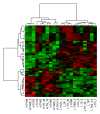Revealing Pathways Associated with Feed Efficiency and Meat Quality Traits in Slow-Growing Chickens
- PMID: 34679997
- PMCID: PMC8532858
- DOI: 10.3390/ani11102977
Revealing Pathways Associated with Feed Efficiency and Meat Quality Traits in Slow-Growing Chickens
Abstract
Here, molecular pathways and genes involved in the feed efficiency (FE) and thigh-meat quality of slow-growing Korat chickens were investigated. Individual feed intake values and body weights were collected weekly to the calculate feed conversion ratios (FCR) and residual feed intake. The biochemical composition and meat quality parameters were also measured. On the basis of extreme FCR values at 10 weeks of age, 9 and 12 birds from the high and the low FCR groups, respectively, were selected, and their transcriptomes were investigated using the 8 × 60 K Agilent chicken microarray. A weighted gene co-expression network analysis was performed to determine the correlations between co-expressed gene modules and FE, thigh-meat quality, or both. Groups of birds with different FE values also had different nucleotide, lipid, and protein contents in their thigh muscles. In total, 38 modules of co-expressed genes were identified, and 12 were correlated with FE and some meat quality traits. A functional analysis highlighted several enriched functions, such as biological processes, metabolic processes, nucleotide metabolism, and immune responses. Several molecular factors were involved in the interactions between FE and meat quality, including the assembly competence domain, baculoviral IAP repeat containing 5, cytochrome c oxidase assembly factor 3, and myosin light chain 9 genes.
Keywords: Korat chicken; feed efficiency; meat quality; slow-growing chicken; transcriptome.
Conflict of interest statement
The authors declare no conflict of interest.
Figures


Similar articles
-
Thigh muscle metabolic response is linked to feed efficiency and meat characteristics in slow-growing chicken.Poult Sci. 2023 Jul;102(7):102741. doi: 10.1016/j.psj.2023.102741. Epub 2023 Apr 23. Poult Sci. 2023. PMID: 37186966 Free PMC article.
-
Phenotypic correlations between feed efficiency, growth, and meat quality of slow-growing chickens.Br Poult Sci. 2022 Dec;63(6):742-746. doi: 10.1080/00071668.2022.2094218. Epub 2022 Jul 1. Br Poult Sci. 2022. PMID: 35749274
-
The significant influence of residual feed intake on flavor precursors and biomolecules in slow-growing Korat chicken meat.Anim Biosci. 2021 Oct;34(10):1684-1694. doi: 10.5713/ab.20.0736. Epub 2021 Feb 15. Anim Biosci. 2021. PMID: 33677913 Free PMC article.
-
Jejunal Transcriptomic Profiling for Differences in Feed Conversion Ratio in Slow-Growing Chickens.Animals (Basel). 2021 Sep 5;11(9):2606. doi: 10.3390/ani11092606. Animals (Basel). 2021. PMID: 34573572 Free PMC article.
-
Review: Biological determinants of between-animal variation in feed efficiency of growing beef cattle.Animal. 2018 Dec;12(s2):s321-s335. doi: 10.1017/S1751731118001489. Epub 2018 Aug 24. Animal. 2018. PMID: 30139392 Review.
Cited by
-
Genome-Wide Association Study of Feed Efficiency Related Traits in Ducks.Animals (Basel). 2022 Jun 13;12(12):1532. doi: 10.3390/ani12121532. Animals (Basel). 2022. PMID: 35739869 Free PMC article.
-
Metagenomic insights into the relationship between gut microbiota and residual feed intake of small-sized meat ducks.Front Microbiol. 2023 Jan 18;13:1075610. doi: 10.3389/fmicb.2022.1075610. eCollection 2022. Front Microbiol. 2023. PMID: 36741899 Free PMC article.
-
Integrated Transcriptomics Profiling in Chahua and Digao Chickens' Breast for Assessment Molecular Mechanism of Meat Quality Traits.Genes (Basel). 2022 Dec 28;14(1):95. doi: 10.3390/genes14010095. Genes (Basel). 2022. PMID: 36672833 Free PMC article.
-
Residual feed intake in late-laying hens: immune function, metabolic efficiency, and feed utilization dynamics.Front Vet Sci. 2025 Jul 7;12:1624978. doi: 10.3389/fvets.2025.1624978. eCollection 2025. Front Vet Sci. 2025. PMID: 40693113 Free PMC article.
-
Multi-breed host rumen epithelium transcriptome and microbiome associations and their relationship with beef cattle feed efficiency.Sci Rep. 2023 Sep 27;13(1):16209. doi: 10.1038/s41598-023-43097-8. Sci Rep. 2023. PMID: 37758745 Free PMC article.
References
Grants and funding
LinkOut - more resources
Full Text Sources
Molecular Biology Databases
Research Materials

